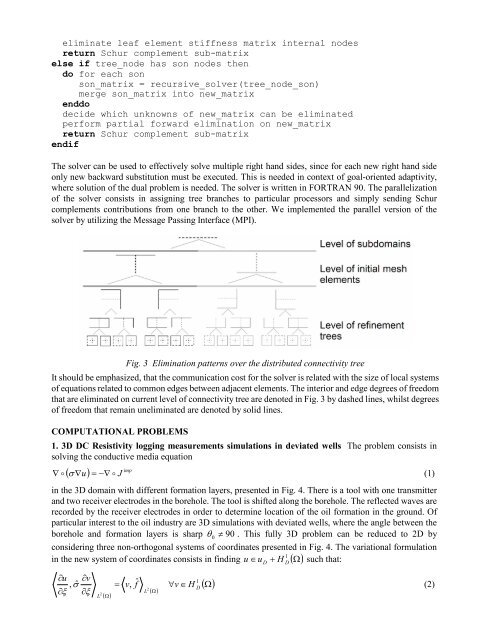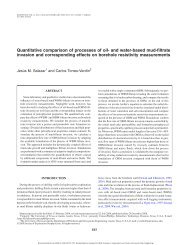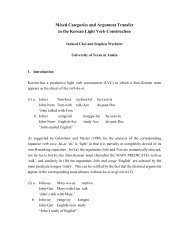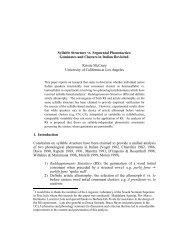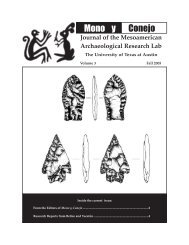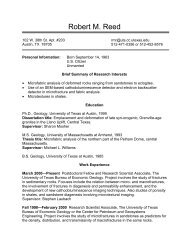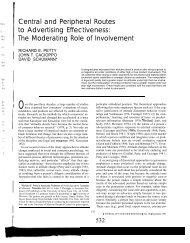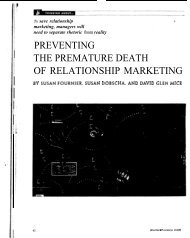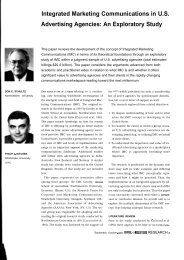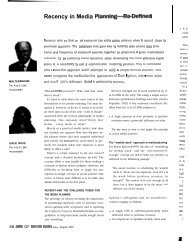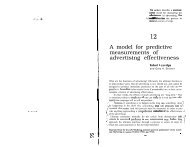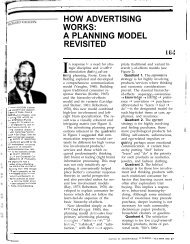APCOM'07 in conjunction with EPMESC XI, December 3-6, 2007 ...
APCOM'07 in conjunction with EPMESC XI, December 3-6, 2007 ...
APCOM'07 in conjunction with EPMESC XI, December 3-6, 2007 ...
Create successful ePaper yourself
Turn your PDF publications into a flip-book with our unique Google optimized e-Paper software.
elim<strong>in</strong>ate leaf element stiffness matrix <strong>in</strong>ternal nodes<br />
return Schur complement sub-matrix<br />
else if tree_node has son nodes then<br />
do for each son<br />
son_matrix = recursive_solver(tree_node_son)<br />
merge son_matrix <strong>in</strong>to new_matrix<br />
enddo<br />
decide which unknowns of new_matrix can be elim<strong>in</strong>ated<br />
perform partial forward elim<strong>in</strong>ation on new_matrix<br />
return Schur complement sub-matrix<br />
endif<br />
The solver can be used to effectively solve multiple right hand sides, s<strong>in</strong>ce for each new right hand side<br />
only new backward substitution must be executed. This is needed <strong>in</strong> context of goal-oriented adaptivity,<br />
where solution of the dual problem is needed. The solver is written <strong>in</strong> FORTRAN 90. The parallelization<br />
of the solver consists <strong>in</strong> assign<strong>in</strong>g tree branches to particular processors and simply send<strong>in</strong>g Schur<br />
complements contributions from one branch to the other. We implemented the parallel version of the<br />
solver by utiliz<strong>in</strong>g the Message Pass<strong>in</strong>g Interface (MPI).<br />
Fig. 3 Elim<strong>in</strong>ation patterns over the distributed connectivity tree<br />
It should be emphasized, that the communication cost for the solver is related <strong>with</strong> the size of local systems<br />
of equations related to common edges between adjacent elements. The <strong>in</strong>terior and edge degrees of freedom<br />
that are elim<strong>in</strong>ated on current level of connectivity tree are denoted <strong>in</strong> Fig. 3 by dashed l<strong>in</strong>es, whilst degrees<br />
of freedom that rema<strong>in</strong> unelim<strong>in</strong>ated are denoted by solid l<strong>in</strong>es.<br />
COMPUTATIONAL PROBLEMS<br />
1. 3D DC Resistivity logg<strong>in</strong>g measurements simulations <strong>in</strong> deviated wells The problem consists <strong>in</strong><br />
solv<strong>in</strong>g the conductive media equation<br />
imp<br />
( ∇u)<br />
= o J<br />
∇ o σ −∇<br />
(1)<br />
<strong>in</strong> the 3D doma<strong>in</strong> <strong>with</strong> different formation layers, presented <strong>in</strong> Fig. 4. There is a tool <strong>with</strong> one transmitter<br />
and two receiver electrodes <strong>in</strong> the borehole. The tool is shifted along the borehole. The reflected waves are<br />
recorded by the receiver electrodes <strong>in</strong> order to determ<strong>in</strong>e location of the oil formation <strong>in</strong> the ground. Of<br />
particular <strong>in</strong>terest to the oil <strong>in</strong>dustry are 3D simulations <strong>with</strong> deviated wells, where the angle between the<br />
borehole and formation layers is sharp θ 90 . This fully 3D problem can be reduced to 2D by<br />
0 ≠<br />
consider<strong>in</strong>g three non-orthogonal systems of coord<strong>in</strong>ates presented <strong>in</strong> Fig. 4. The variational formulation<br />
u ∈ u<br />
1<br />
+ H Ω such that:<br />
<strong>in</strong> the new system of coord<strong>in</strong>ates consists <strong>in</strong> f<strong>in</strong>d<strong>in</strong>g ( )<br />
∂u<br />
∂v<br />
1<br />
, ˆ σ = v,<br />
fˆ<br />
∀v<br />
∈ H<br />
2<br />
D<br />
∂ξ<br />
∂ξ<br />
L ( Ω)<br />
2<br />
L<br />
( Ω)<br />
( Ω)<br />
D<br />
D<br />
(2)


